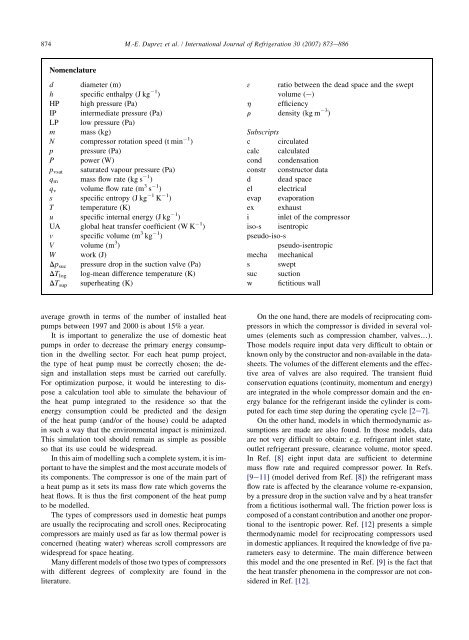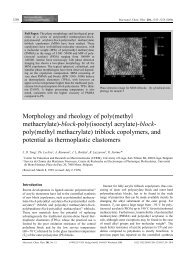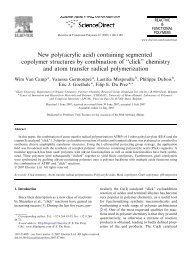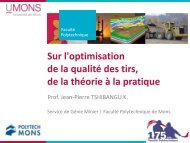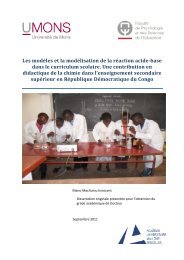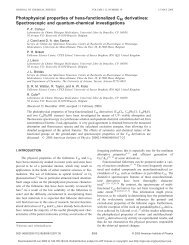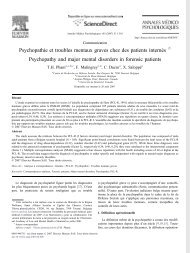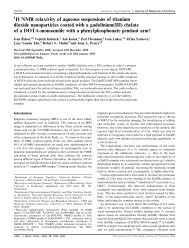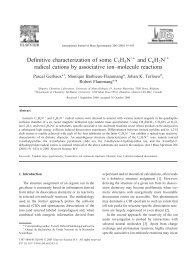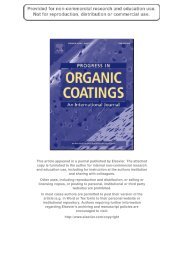Modelling of reciprocating and scroll compressors Modélisation des ...
Modelling of reciprocating and scroll compressors Modélisation des ...
Modelling of reciprocating and scroll compressors Modélisation des ...
Create successful ePaper yourself
Turn your PDF publications into a flip-book with our unique Google optimized e-Paper software.
874 M.-E. Duprez et al. / International Journal <strong>of</strong> Refrigeration 30 (2007) 873e886Nomenclatured diameter (m)h specific enthalpy (J kg 1 )HP high pressure (Pa)IP intermediate pressure (Pa)LP low pressure (Pa)m mass (kg)N compressor rotation speed (t min 1 )p pressure (Pa)P power (W)p vsat saturated vapour pressure (Pa)q m mass flow rate (kg s 1 )q v volume flow rate (m 3 s 1 )s specific entropy (J kg 1 K 1 )T temperature (K)u specific internal energy (J kg 1 )UA global heat transfer coefficient (W K 1 )v specific volume (m 3 kg 1 )V volume (m 3 )W work (J)Dp suc pressure drop in the suction valve (Pa)DT log log-mean difference temperature (K)superheating (K)DT sup3 ratio between the dead space <strong>and</strong> the sweptvolume (e)h efficiencyr density (kg m 3 )Subscriptsc circulatedcalc calculatedcond condensationconstr constructor datad dead spaceel electricalevap evaporationex exhausti inlet <strong>of</strong> the compressoriso-s isentropicpseudo-iso-spseudo-isentropicmecha mechanicals sweptsuc suctionw fictitious wallaverage growth in terms <strong>of</strong> the number <strong>of</strong> installed heatpumps between 1997 <strong>and</strong> 2000 is about 15% a year.It is important to generalize the use <strong>of</strong> domestic heatpumps in order to decrease the primary energy consumptionin the dwelling sector. For each heat pump project,the type <strong>of</strong> heat pump must be correctly chosen; the <strong>des</strong>ign<strong>and</strong> installation steps must be carried out carefully.For optimization purpose, it would be interesting to disposea calculation tool able to simulate the behaviour <strong>of</strong>the heat pump integrated to the residence so that theenergy consumption could be predicted <strong>and</strong> the <strong>des</strong>ign<strong>of</strong> the heat pump (<strong>and</strong>/or <strong>of</strong> the house) could be adaptedin such a way that the environmental impact is minimized.This simulation tool should remain as simple as possibleso that its use could be wi<strong>des</strong>pread.In this aim <strong>of</strong> modelling such a complete system, it is importantto have the simplest <strong>and</strong> the most accurate models <strong>of</strong>its components. The compressor is one <strong>of</strong> the main part <strong>of</strong>a heat pump as it sets its mass flow rate which governs theheat flows. It is thus the first component <strong>of</strong> the heat pumpto be modelled.The types <strong>of</strong> <strong>compressors</strong> used in domestic heat pumpsare usually the <strong>reciprocating</strong> <strong>and</strong> <strong>scroll</strong> ones. Reciprocating<strong>compressors</strong> are mainly used as far as low thermal power isconcerned (heating water) whereas <strong>scroll</strong> <strong>compressors</strong> arewi<strong>des</strong>pread for space heating.Many different models <strong>of</strong> those two types <strong>of</strong> <strong>compressors</strong>with different degrees <strong>of</strong> complexity are found in theliterature.On the one h<strong>and</strong>, there are models <strong>of</strong> <strong>reciprocating</strong> <strong>compressors</strong>in which the compressor is divided in several volumes(elements such as compression chamber, valves.).Those models require input data very difficult to obtain orknown only by the constructor <strong>and</strong> non-available in the datasheets.The volumes <strong>of</strong> the different elements <strong>and</strong> the effectivearea <strong>of</strong> valves are also required. The transient fluidconservation equations (continuity, momentum <strong>and</strong> energy)are integrated in the whole compressor domain <strong>and</strong> the energybalance for the refrigerant inside the cylinder is computedfor each time step during the operating cycle [2e7].On the other h<strong>and</strong>, models in which thermodynamic assumptionsare made are also found. In those models, dataare not very difficult to obtain: e.g. refrigerant inlet state,outlet refrigerant pressure, clearance volume, motor speed.In Ref. [8] eight input data are sufficient to determinemass flow rate <strong>and</strong> required compressor power. In Refs.[9e11] (model derived from Ref. [8]) the refrigerant massflow rate is affected by the clearance volume re-expansion,by a pressure drop in the suction valve <strong>and</strong> by a heat transferfrom a fictitious isothermal wall. The friction power loss iscomposed <strong>of</strong> a constant contribution <strong>and</strong> another one proportionalto the isentropic power. Ref. [12] presents a simplethermodynamic model for <strong>reciprocating</strong> <strong>compressors</strong> usedin domestic appliances. It required the knowledge <strong>of</strong> five parameterseasy to determine. The main difference betweenthis model <strong>and</strong> the one presented in Ref. [9] is the fact thatthe heat transfer phenomena in the compressor are not consideredin Ref. [12].


